Choosing the wrong blade for your project can be really frustrating, especially when you’re dealing with wood, metal, or other tough materials. The key to a successful project lies in having the right blade—it makes things efficient and ensures good results.
Don’t worry, we’re here to help! This guide will show you how to pick the best miter saw blade that gets straight to the point, making your projects a breeze.
Here are some important things to consider:
- Blade Material: Consider the type of material you’ll be cutting most frequently, such as wood, metal, or laminate. Choose a blade specifically designed for that material to ensure clean and precise cuts.
- Number of Tooth Configuration: The number of teeth on a blade affects its cutting speed and finish. Blades with more teeth provide smoother finishes but may cut more slowly.
- Blade Size and Arbor Size: Ensure that the blade size matches the specifications of your miter saw. Common sizes include 10 inches and 12 inches. Check the arbor size to confirm it matches the arbor size of your miter saw. The arbor size is the diameter of the hole in the center of the blade.
A comprehensive “Buying Guide“ is also provided for selecting the perfect blade for your application. Read on for a quick guide. Meanwhile here is a list crafted for you to buy best miter saw blades.
Best Miter Saw/Table Saw Blades
| Miter Saw/Table Saw Blades | Blade Material | No. Of Teeth | Warranty | Buy Now |
|---|---|---|---|---|
| DEWALT Miter Saw Blade | Carbide | 60-Tooth & 32-Tooth | 5/8 | Check On Amazon |
| Craftsman Miter Saw Blade | Carbide | 24 and 60 | - | Check On Amazon |
| IRWIN Miter Saw Blade | Blend | 180 | 5/8 | Check On Amazon |
| GoYonder Miter Saw Blade | Diamond | - | 5/8 | Check On Amazon |
| Freud Miter Saw Blade | Blend | 50 | 5/8 | Check On Amazon |
| WEN Miter Saw Blade | Diamond | 4 | 5/8 | Check On Amazon |
| NEIKO Miter Saw Blade | Carbide | 80 | 20 mm | Check On Amazon |
Best Miter Saw/Table Saw Blades Reviews
1. DEWALT Miter Saw Blade
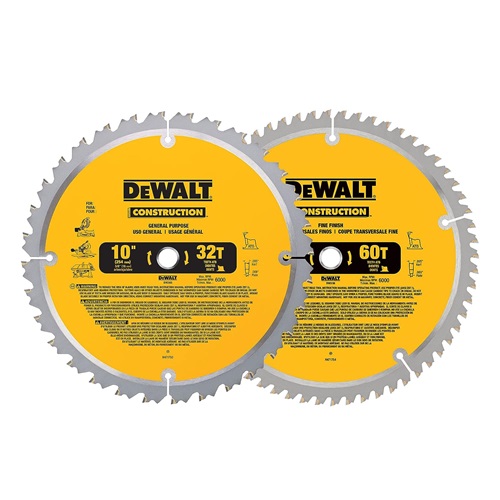
The blades have a special design (7-degree ATB) for fast and smooth cuts, and they don’t overheat thanks to slots that let out heat. They also won’t get stuck easily, making your cuts safer and smoother.
Best Features:
|
Features |
Description |
|
Blades Included |
60-tooth crosscutting blade, 32-tooth general-purpose blade |
|
Blade Material |
Carbide |
|
Arbor Size |
5/8” |
|
Compatibility |
Table saws, miter saws, radial arm saws, chop saws |
|
Blade Design |
7-degree ATB (Alternate Top Bevel) |
|
Plate Thickness |
Thin |
|
Heat Dispersion |
Expansion slots for heat dispersion |
|
Application |
Cross-cutting, ripping |
|
Arbor Size |
1 inch (20 mm arbor reducer included) |
|
Maximum RPM |
5000 |
Pros:-
- Multi-Use Blades Set.
- Affordable.
- Cuts smooth without any strain on the motor of the saw.
- Quality blades.
Cons:-
- These blades are thin and may deflect easily when pushed against thicker materials.
2. Craftsman Miter Saw Blade
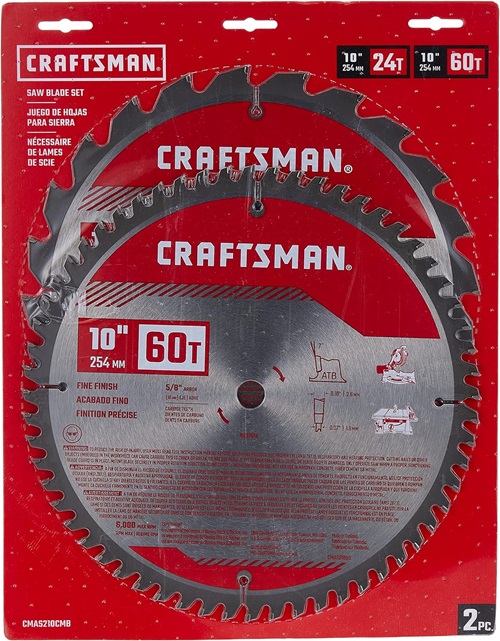
The induction-brazed carbide tips enhance durability, ensuring a long blade life. The heat-treated plate eliminates warping, promoting consistent and accurate cuts. Precision ground teeth contribute to smooth and accurate cuts, while the corrosion-resistant coating prevents rust, ensuring a long-lasting and reliable tool for your projects.
Best Features:
| Features | Description |
| Blade Material | Carbide |
| Brand | Craftsman |
| Product Dimensions | 10″L x 10″W |
| Number of Teeth | 24 and 60 |
| Number of Pieces | 1 |
| Included Blades | 10-inch 24T Framing/Ripping Saw Blade and 10-inch 60T Fine Finish Saw Blade |
| Application | Versatile for various cutting tasks |
Pros:-
- Sharp blades and will cut with ease.
- Durability and longevity.
- Great blades for the price.
Cons:-
- 60 tooth blade dull after one work day.
- Will stay sharp for 20 cuts, as per user review.
3. IRWIN Miter Saw Blade
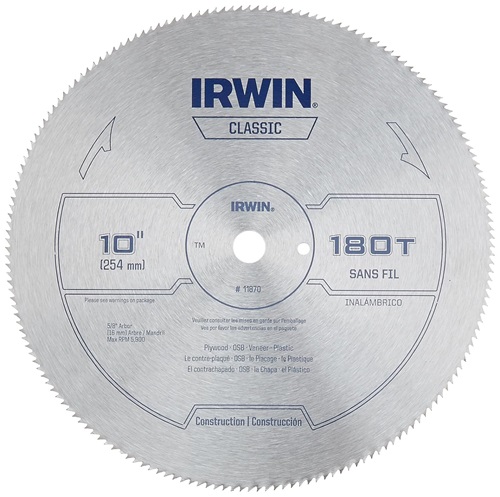
The precision-ground circular saw teeth enhance cutting accuracy, while the fully-hardened circular saw blade plate ensures a truer and longer-lasting performance. The heavy-gauge, high-carbon steel construction adds durability, providing an extended life for the circular saw blade. With a top/face grind on the 180 teeth, this blade delivers top-notch cutting efficiency.
Best Features:
| Features | Description |
| Blade Material | Blend |
| Number of Teeth | 180 |
| Item Weight | 1.3 Pounds |
| Compatible Material | Engineered Wood, Alloy Steel, Plastic |
| Teeth Type | Precision-ground circular saw teeth |
| Construction Material | Heavy-gauge, high-carbon steel |
| Blade Length | 10 inches |
| Arbor Size | 5/8″ |
| Kerf | 0.09″ |
Pros:-
- Basic fine toothed blade.
- cheap blade good for less than 1000 sq ft trim.
- Worked great for cutting a 24×36 1/8 inch plexiglass sheets.
Cons:-
- Short Life Span under Limited Use.
4. GoYonder Miter Saw Blade
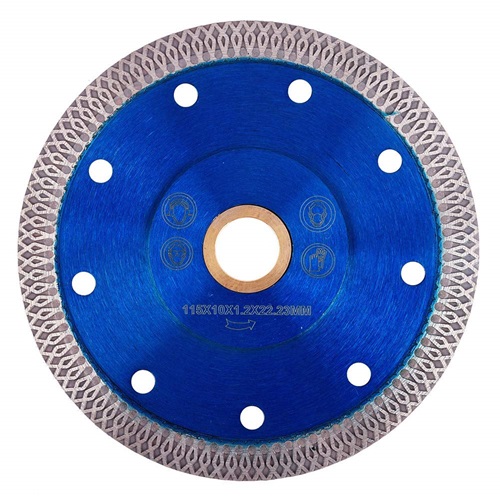
This diamond blade features a distinctive X Teeth Turbo Mesh Rim Design, providing fast, smooth, and precise cuts with minimal dust and vibration. Additionally, the statement emphasizes that the tile blade performs exceptionally well for both wet and dry cutting applications, making it suitable for various tools such as hand-held angle grinder saws, air cut-off tools, and electric cut-off tools.
Best Features:
| Features | Description |
| Blade Material | Diamond |
| Compatible Material | Porcelain, Glass, Ceramic, Marble, Stone |
| Number of Pieces | 1 |
| Arbor Sizes | 5/8″ |
| Wet & Dry Cutting Options | Yes |
| X Teeth Turbo Mesh Design | Yes |
| Blade Thickness | 1.2mm |
| Outer Diameter | 115mm / 4.5 inch |
| Segment Height | 10mm |
| Max Speed | 13200 rpm, 80m/s |
| Application | Porcelain tile, Granite, Marble, Stone, Ceramic |
Pros
- Cuts like proverbial butter.
- Actually incredibly impressed how easily this cuts through the thick tiles.
- Great value for the money.
Cons:-
- Disc warps easily.
- Horrible Cuts.
5. Freud Miter Saw Blade
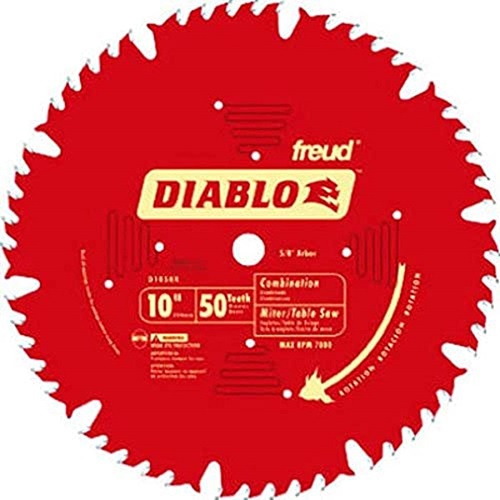
The blade incorporates laser-cut stabilizer vents, ensuring a cooler operation by trapping noise and vibration, while the laser-cut heat expansion slots prevent warping and maintain a true, straight cut. With micrograin titanium carbide construction, this blade offers extreme durability, razor-sharp cuts, and an extended lifespan. The laser-cut arbor promotes accurate blade rotation, reducing vibration and premature wear.
Best Features:
| Features | Description |
| Blade Material | Blend |
| Product Dimensions | 10″L x 10″W |
| Number of Teeth | 50 |
| Compatible Material | Alloy Steel, Metal |
| Number of Pieces | 1 |
| Arbor Size | 5/8″ |
| Laser-Cut Stabilizer Vents | Yes |
Pros:-
- Blade cuts FANTASTIC.
- Suited for cross cutting.
- Very clean cut.
- Rips plywood and hardwood very well.
Cons:-
- Not long lasting.
6. WEN Miter Saw Blade
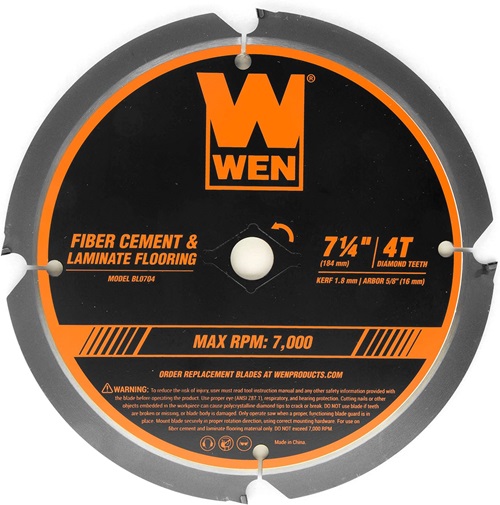
Wen miter saw blade is designed for slicing through fiber cement board and laminate flooring, this blade is equipped with a unique PCD formula that fights off wear and tear caused by highly abrasive materials, ensuring longevity. The heat expansion slots allow the blade to adapt to various cutting conditions, maintaining maximum accuracy.
Best Features:
| Features | Description |
| Blade Material | Diamond |
| Number of Teeth | 4 |
| Style | Circular, Unique |
| Diameter | 7-1/4 inches (184 mm) |
| Arbor Size | 5/8 inch (15.88 mm) |
| RPM Rating | Up to 7000 |
| Compatibility | 7-1/4-inch circular saws, jobsite saws, track saws |
| Kerf Thickness | 1/15 inch (1.8 mm) |
| Application | Fiber cement board, laminate flooring |
Pros:-
- Cuts cement board very well – clean and fast.
- Excellent performance at a very good price.
- Minimal dust, smooth clean cuts.
- Very good for laminate flooring.
Cons:-
- Didn’t last long.
- Made a very rough cut.
7. NEIKO Miter Saw Blade
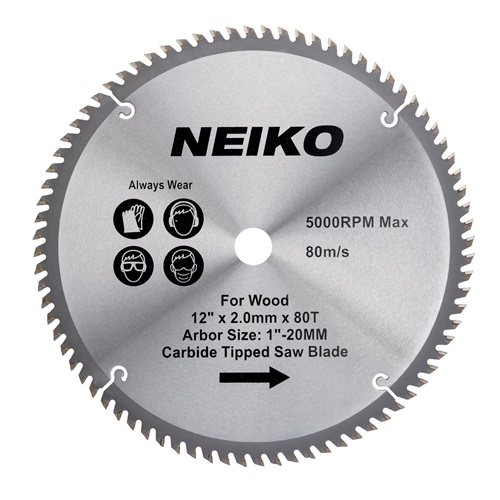
The blade is great for various woodworking projects, giving you the ability to make straight and angled cuts. Whether you’re a DIY enthusiast or a professional, the NEIKO 10768A Carbide Saw Blade is a reliable choice for achieving accurate and clean cuts in your woodworking projects.
Best Features:
| Features | Description |
| Blade Material | Carbide |
| Brand | Neiko |
| Number of Teeth | 80 |
| Style | Modern |
| Item Weight | 2.5 Pounds |
| Compatible Material | Wood |
| Number of Pieces | 1 |
| Diameter | 12 inches |
| Arbor Size | 1 inch (20 mm arbor reducer included) |
| Maximum RPM | 5000 |
Pros:-
- Works fine, good price.
- Excellent Blade for the Price.
Cons:-
- Dulls pretty quickly.
- Not as sharp as it should be.
Buying Guide for Best Miter Saw Blades
1. Blade Material
The material from which the blade is made significantly impacts its performance and longevity. Carbide-tipped blades are highly recommended for their durability and extended sharpness.
Carbide is a hard and robust material that can withstand the rigors of cutting through various materials. It retains its sharp edge much longer than traditional steel blades, reducing the need for frequent replacements.
In addition to carbide-tipped blades, there are several other common blade materials used in the manufacturing of saw blades, each with its own set of characteristics. The best material for a user depends on their specific needs and preferences. Here are a few alternative blade materials:
a. High-Speed Steel (HSS):
- High-speed steel blades are known for their durability and ability to maintain sharpness at high speeds.
- These blades are more affordable than carbide-tipped blades and are suitable for cutting softer materials like wood and plastic.
- While durable, HSS blades may not retain their edge as long as carbide blades, especially when cutting through abrasive materials.
b. Bi-Metal:
- Bi-metal blades combine the durability of HSS with the heat resistance of a different material, typically cobalt or tungsten.
- These blades offer a good balance of durability and heat resistance, making them suitable for cutting through a variety of materials, including metals.
- Bi-metal blades are often more expensive than HSS blades but may not match the longevity of carbide-tipped blades.
c. Diamond-Coated:
- Diamond-coated blades have a layer of synthetic diamond particles bonded to the cutting edge.
- Ideal for cutting hard and abrasive materials like tile, ceramics, and concrete. Diamond-coated blades provide excellent cutting precision.
- They can be more expensive, and their effectiveness may decrease over time, especially with prolonged use on extremely hard materials.
d. Steel Blades:
- Traditional steel blades are common and economical.
- They are affordable and suitable for basic cutting tasks in softer materials.
- Steel blades may dull more quickly than carbide or bi-metal blades, requiring more frequent sharpening or replacement.
2. Number Of Tooth Configuration
The two primary aspects to focus on are the number of teeth on the blade and the Teeth Per Inch (TPI) metric.
- Number of Teeth: Blades come with varying numbers of teeth, and this number significantly influences the cutting action.
- More Teeth: Blades with a higher tooth count provide a finer finish. They excel at producing smooth and precise cuts, making them ideal for tasks such as cross cutting in wood and other soft materials. These blades are commonly used in applications where a clean and polished result is crucial, such as fine woodworking or cabinetry.
- Fewer Teeth: Blades with fewer teeth are designed for fast material removal and efficient ripping through material. These blades are well-suited for rough cuts where the finish is not the primary concern. They work efficiently when speed and material removal are prioritized over a polished surface.
3. Teeth Per Inch (TPI)
TPI is a metric that defines the number of teeth present in one inch of the blade. It is a crucial specification to consider when choosing a saw blade.
- Higher TPI: Blades with a higher TPI value are suitable for fine woodworking tasks. They are effective in producing intricate and detailed cuts, especially in materials like hardwood or plywood. Higher TPI values contribute to a smoother finish and are preferred when precision is paramount.
- Lower TPI: Blades with a lower TPI value are designed for rough cuts and tasks that require fast material removal. They are commonly used in applications like framing or when cutting through softwood. Lower TPI values enhance the blade’s ability to clear away material quickly, making them suitable for tasks where speed is essential, and a refined finish is less critical. Choosing the right tooth configuration depends on the specific requirements of the cutting task:
- Fine Woodworking: Tasks that demand precision and a polished finish benefit from blades with more teeth and a higher TPI.
- Rough Cuts and Material Removal: For applications where speed and efficient material removal are prioritized over finish, blades with fewer teeth and a lower TPI are more suitable.
4. Blade Size and Arbor Size
Selecting the right blade size and arbor size is crucial for ensuring compatibility, safety, and optimal performance in your miter saw. Here’s an in-depth look at these considerations:
- Blade Size: Miter saw blades come in various sizes, with 10 inches and 12 inches being common options. It is essential to choose a blade size that aligns with the specifications of your miter saw. A 10-inch blade is suitable for miter saws designed for that size, while a 12-inch blade is intended for miter saws with the corresponding capacity. Check your miter saw’s manual or markings to determine the recommended blade size.The choice between a 10-inch and 12-inch blade depends on the type of cutting tasks you plan to undertake. Smaller blades are often suitable for general-purpose cutting, while larger blades are favored for tasks requiring increased depth and capacity.
- Arbor Size: The arbor size is the diameter of the hole in the center of the saw blade. It is crucial to check and confirm that the arbor size of the blade matches the arbor size of your miter saw. Common arbor sizes for miter saw blades include 5/8 inches and 1 inch. Some blades may also come with additional bushings or reducers to accommodate different arbor sizes. Verify the arbor size specified by your miter saw’s manufacturer to ensure a proper fit.
Using a blade with an incorrect arbor size can result in wobbling, vibration, and an increased risk of accidents.
Best Miter Saw Blades – FAQs
Ans: For general woodworking, a carbide-tipped blade with a higher tooth count provides clean cuts. If you’re cutting through metal, opt for a specialized metal-cutting blade. Choose a blade that matches your project needs for optimal results.
Ans: Miter saw blades and circular saw blades are both types of circular saw blades, but they may have design differences for specific applications. Choose the appropriate blade based on your tool and the type of cuts you need.
Ans: Saw blades with a higher tooth count generally make smoother cuts. Blades with more teeth create finer finishes, resulting in cleaner and smoother cuts, especially in materials like wood.
Ans: To break in a new saw blade:
* Install Properly: Ensure the blade is correctly installed on the saw, following the manufacturer’s guidelines.
* Idle Run: Run the saw with the blade at a no-load, idle speed for a few minutes. This helps the blade adjust to its rotation and minimizes stress on the teeth.
* Test Cut: Make a few test cuts on scrap material to allow the blade to settle and adapt to cutting conditions.
* Monitor Performance: Pay attention to the blade’s performance during the initial cuts, ensuring smooth operation and minimal vibration.
Ans: Miter saw blades, especially carbide-tipped ones, are usually not sharpened at home. It’s more cost-effective to replace the blade when dull. Regular maintenance and proper use help extend its lifespan.
Conclusion
We’ve provided the best buying options for the perfect miter saw blade, along with a dedicated buying guide above to assist you in making an informed decision. If you’re still unsure, check out our top recommendations listed below.
- If you’re looking for more teeth IRWIN Miter Saw Blade.With a blend material construction, this 180-tooth blade excels in cutting wood, steel, and plastic. Its 10-inch length and 5/8-inch arbor offer versatility for different applications.
- If you’re working with materials like porcelain tiles, granite, marble, ceramics, glass, or stone, the GoYonder Miter Saw Blade is a diamond-cutting marvel. With a 115mm outer diameter and 10mm segment height this blade delivers fast, smooth, and precise cuts.
- If you’re working for fiber cement board and laminate flooring, WEN Miter Saw Blade. Its ultra-thin 1/15-inch kerf minimizes material waste, and the unique PCD formula fights wear and tear caused by abrasive materials.

